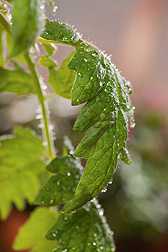Study: Pretreating Plants With Aspirin-Like Compound May Help Prevent Infection

This photo shows a close-up of tomato leaves sprayed with the salicylic acid pretreatment.
Photo credit: Peggy Greb, USDA
For thousands of years, salicylic acid has been extracted from willow tree bark to alleviate minor pain, fever, and inflammation. Today, it’s used in acne medication, wart removers, and other cosmetic products.
Now, findings by USDA scientists suggest salicylic acid may also offer “relief” to crop plants by priming their defenses against a microbial pest known as potato purple top phytoplasma, a bacterium that has no cell walls. Outbreaks of the bacterium in the fertile Columbia Basin region of the Pacific Northwest in 2002 and subsequent years inflicted severe potato yield and quality losses.
Carefully timed insecticide applications can deter beet leafhoppers from transmitting the phytoplasma while feeding. But once infected, the plant cannot be cured, according to Yan Zhao, a molecular biologist at the Molecular Plant Pathology Laboratory, operated in Beltsville, MD, by USDA’s Agricultural Research Service (ARS).
In studies there, Zhao and his colleagues have collected evidence that pre-treating tomato plants — a relative of potato — with salicylic acid can prevent phytoplasma infections from occurring or at least diminish their severity.
For their research, published in the July 2012 Annals of Applied Biology, the team used two groups: an experimental one that included potted tomato seedlings and a second group of the plants, known as the control group, for comparison. The experimental group received two salicylic acid treatments — the first via a spray solution four weeks after planting the seedlings, and the second via a root drench two days before phytoplasma-infected scions were grafted onto the plants’ stems to induce disease. The control group wasn’t treated.
The team visually checked for disease symptoms and analyzed leaf samples for the phytoplasma’s unique DNA fingerprint, which turned up in 94% of samples from untreated plants and 47% of treated ones. Significantly, the remaining 53% of treated plants were symptom- and pathogen-free 40 days after exposure to the infected scions.
Researchers credit salicylic acid with triggering systemic acquired resistance, a kind of general readiness state that primes plant defenses against pending microbial or insect attack.
Read more about this research in the February 2014 issue of Agricultural Research magazine.
Source: Jan Suszkiw, USDA-ARS










